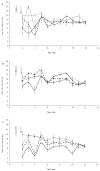Changes of Heart Rate and Lipid Composition in Mytilus Edulis and Modiolus Modiolus Caused by Crude Oil Pollution and Low Salinity Effects
- PMID: 34069022
- PMCID: PMC8162556
- DOI: 10.3390/jox11020004
Changes of Heart Rate and Lipid Composition in Mytilus Edulis and Modiolus Modiolus Caused by Crude Oil Pollution and Low Salinity Effects
Abstract
Blue mussels, Mytilus edulis, inhabiting tidal zones, are naturally exposed to fluctuating environmental conditions (e.g., fluctuations in temperature and salinities), while horse mussels, Modiolus modiolus, live under relatively invariable shelf water conditions. The present investigation tested the hypothesis: blue mussels, in comparison to horse mussels, have an increased ability to tolerate the stress of pollution combined with low salinity. To assess the response of blue mussels and horse mussels to oil pollution at seawater salinities of 25 psu (normal) and 15 psu (low), we used a combination of heart rate and lipid composition as physiological and biochemical indicators, respectively. A sharp decrease in heart rate as well as important fluctuations in cardiac activity was observed under all oil concentrations. Modifications in the concentrations of the main membrane lipid classes (phosphatidylcholine, phosphatidylethanolamine, and cholesterol) and storage lipids (primarily triacylglycerols) in response to different crude oil concentrations were time- and dose-dependent. Both chosen indicators showed a high sensitivity to crude oil contamination. Furthermore, both bivalve species showed similar responses to oil pollution, suggesting a universal mechanism for biochemical adaptation to crude oil pollution.
Keywords: cardiac activity; cholesterol; mussel; oil pollution; phospholipids; triacylglycerols.
Conflict of interest statement
The authors declare no conflict of interest.
Figures






References
-
- Arctic Monitoring and Assessment Programme (AMAP) AMAP Assessment 2009: Persistent Organic Pollutants in the Arctic. Arctic Monitoring and Assessment Programme (AMAP); Oslo, Norway: 2010.
-
- Anwar N., Richardson C., Seed R. Age determination, growth rate and population structure of the horse mussel Modiolus modiolus. J. Mar. Biol. Assoc. U. K. 1990;70:441–457. doi: 10.1017/S0025315400035529. - DOI
-
- Brooks S.J., Farmen E. The Distribution of the Mussel Mytilus Species along the Norwegian Coast. J. Shellfish Res. 2013;32:265–270. doi: 10.2983/035.032.0203. - DOI
Grants and funding
LinkOut - more resources
Full Text Sources

